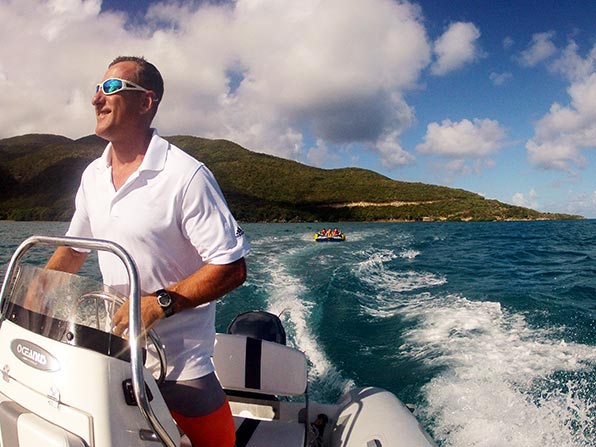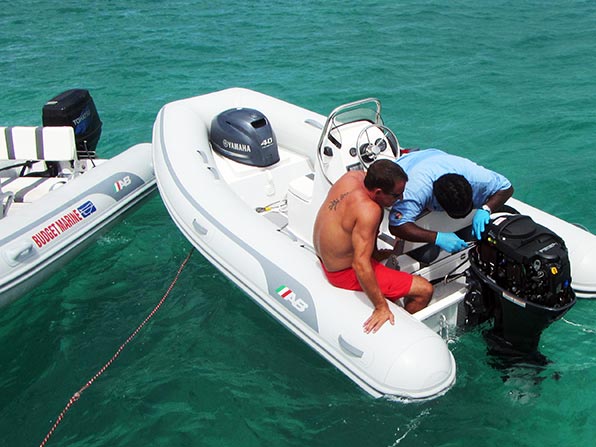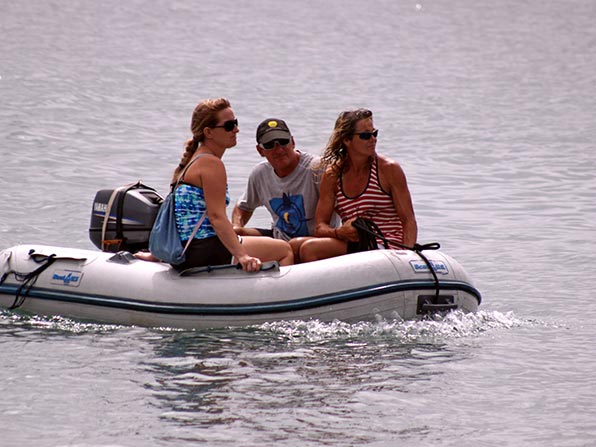Pros and cons of a center-console dinghy
Yesterday, while trying to get our tender out of the narrow and extremely crowded dinghy dock area, I managed to make a pretty tight maneuver, completely avoiding the prop-eating rocks to starboard, and the exposed propellers to port. Once we reached more open water, I commented to Rebecca that I would like to have seen someone do that kind of move with a center console dinghy. Definitely wouldn’t have happened!
When we were outfitting the Leopard for charter, the owner was convinced that we needed to have a large center-console dinghy. In his defense, that is seemingly what every charter broker wants to see on a boat. The tender itself, a RIB with a large outboard, cost a bunch of cash, as did the reinforcements that we felt were necessary in order for the boat to safely carry the extra load. Was it all worth it? I’ll admit that the tender looked good, and it was nice when pulling guests on the inflatable tube, but I cursed that beast frequently. Yes, on more than one occasion, we envied the boats that didn’t follow the herd, and stuck with a normal RIB-outboard combo.

A center console dinghy is perhaps easier for pulling toys. I can’t say for certain though as I’ve never tried to pull toys with a dinghy powered by a tiller outboard.
As I see it, the drawbacks to a center-console dinghy for a normal (non-mega) yacht are as follows:
- The center console takes up a significant amount of room in the RIB, room that could be used for passengers and/or cargo.
- It adds a lot of weight to the setup. This affects raising and carrying the dinghy on davits, and pulling it up on a beach.
- It adds a level of complexity far greater than that found with a tiller-controlled outboard. For example, we had steering cable failures multiple times.
- The wheel significantly reduces the maneuverability of the tender when operating at slow speed, docking, etc. See paragraph one above!
- To have any decent visibility on our setup, I was required to stand up when underway.
- The heavier tender requires a much larger engine to get up on plane.
- The entire setup costs more $$$!

A center console adds a level of complexity far greater
than that found with a tiller-controlled outboard.
What are the advantages? There must be some, right?
- Looks cool, I guess.
- It is perhaps easier for pulling toys. I can’t say for certain though as I’ve never tried to pull toys with a dinghy powered by a tiller outboard.
- The driver is less likely to get a sore neck when driving long distances in bumpy conditions (because of the way that I sit sideways in our dinghy, looking forward, I find that, on rare occasions, I get a stiff neck).
I remember one time we were anchored in Waterlemon Cay, St John, and a multi-million dollar Gunboat catamaran took a mooring ball behind us. I watched the crew lower their traditionally-fitted (outboard with tiller) RIB into the water, and ferry their guests to the snorkel spot. While I thought the situation funny, considering the fact that we had such a splashy tender, I guessed that they were just being super weight conscious with their performance cat. In retrospect though, I think they had it all figured out!

I think we’ll stick with our little RIB and Yamaha combo. Photo courtesy of Dave McGuire.


Thanks for your thoughts. Good to know what your experience has taught you..
You’re welcome.
It’s good to hear the opinion from someone who has had both.
For most cruising boats they’re not even a consideration. If I was outfitting a charter cat again though, I’d definitely avoid the adde weight/expense/complexity.
Does your dinghy have a hard fiberglass bottom, or an inflatable? I’m looking to replace or hard bottom Avon, and am concerned that I’ll be limited too much in speed with a completely inflatable unit, although I like that type for the weight savings. Can you give me some first-hand insight or advice?
Our present dinghy is an older 8.5′ fiberglass RIB (rigid inflatable boat). We love it. Our first dinghy was a Walker Bay PVC soft bottom. We did NOT love that!
Many people concerned with weight are going for Aluminum-bottomed RIBs these days. There is a big weight savings there. If you’re going to be sailing offshore, you need to have a place to store the dinghy. Carrying a soft bottomed tender allows you to completely deflate it and store down below, or in a large locker. That’s ideal. Performance wise though, it’ll never be as quick or solid as a RIB.
Thanks Mike.
We do pull toys with a traditional RIB, and it is painful. Our solution is to have the kids drive, and then its not painful at all.
Good solution!
For simplicity sake you can’t beat a tiller drive. I would personally go with a console type tender, even with the downsides, for the comfort factory. It is hard to drive a larger tender with a large outboard via tiller versus steering cable.
I would say that the tender on the cat you used to run wasn’t the best riding tender (Nanny Cay back to STT), but there are some pretty nice riding center console ribs out there.
From a distance, I always liked the look of Flip Flop’s setup.
Good analysis Mike, but I would add one more item in favor of a console dinghy — dryness. We started with a tiller outboard on a RIB, and that RIB even had “seats” (fiberglass boards from one tube to the other). Mostly because I found that tender hard to drive, especially for long distances, we swapped it for a used side-console model. We get a lot less splash on our bodies in rough water in this dinghy. Maybe not a big deal in the tropics, but going to dinner across Boston Harbor in nice clothes and 60ish water, I’ll take the console model any day.
Of course, we pay the price for that when we have to beach it. Everything is a compromise.
Yes, you’re right. To be fare, I think I may edit the original post to add that, and some of the other things mentioned.
How about a tender that really looks different, can plane with a very small motor, is not an inflatable yet weighs under 100 lbs? Check out the reasonably price NZ dinghy from OCTenders (http://octenders.com)
It would be my choice if I was looking for a new tender. Check out other choices at http://www.adventuresonboats.com/dinghies.html
-johnny
Focus Johnny, this is not a post about inflatables vs. hard dinghies, and you suggested the same thing back in January on this post:
http://www.zerotocruising.com/hard-options/
Since we’re on the subject though, have you ever actually seen this dinghy that you’re recommending, in person? Even more important, have you operated one?
As I noted the last time you suggested this (January), I contacted them last September and they told me they were not available here (they are made in New Zealand).
I’ve never liked sitting on the tubes for long when alone. I carry a tiller extension and sit on the seat facing forward. The boat rides better. Often I can steer by simply leaning to one side.
I agree, every tender is more stable with two people in it to balance the load, and that includes center consoles. As for our little RIB, we removed the seat, and I’m not coordinated enough to use a tiller extension. 🙂
We just switched from a RIB caribe with a 15hp 2 stroke to a nesting rowing/sailing dinghy with a 3.5hp. It is a 10ft dinghy but nest to a 5.5 ft dinghy and fits on the aft deck. Engine weights 28lbs and the dinghy can be put together in the water. There is one Amel 53 out there with a center dinghy. The have no choice and have to use davits off shore. To me it just looks funny and a possible danger. At least with a regular rib you can flip it upside down on the davits and have the water break over it.
I have never seen anyone hang a RIB upside down in their davits. On the deck, definitely, but not on davits. You’d have to create some weird jury rig to make that happen.
Yeah, I’ve had both and now miss my centre console. Heaps more comfortable ride and dryer this makes g long water or people runs safer and more comfortable. Ours had a 40hp which also meant we could ski and wakeboard . I now have a 3.1 with. 15hp. Still pulls the kids on a wakeboard but lots less comfort. Pros are easier to beach with wheels, easier on Davies and cheaper 7k as opposed to 20k. If you can afford it and have Davis to lift one I’d go for the console. Not sure how you found manoeuvring your tender easier. A wheel I found was easier as did the kids.
I believe it’s easier to maneuver because you can move the engine all the way from port to starboard with a tiller with one super-quick movement. Like the rest of this post, your milage may vary.
I’ll concede the dryer ride part, but only for the driver and anyone sitting on a seat in the middle. For the people siting on the tubes though, it’s only dryer if the tubes and engine are larger. Otherwise, they would be the same.
I love to learn. Especially this charter stuff!
When it comes to charter boats and their large center console dinghies, we found that they almost always towed then behind the boat. This is partly because most don’t have the setup to lift and carry them properly, and partly because it just takes too much effort!
Mike you are getting a sore neck because you are sitting on the wrong side. The outboard motor is designed to be operated from the starboard side using you left hand on the tiller. Bill
I know that now but after doing it this way for so long, there’s no way I am changing. Funny that I started on the left side. 🙂
I don’t think that has anything to do with my neck though. If you’re sitting sideways but looking forward, your next gets tweaked when the dinghy bounces.